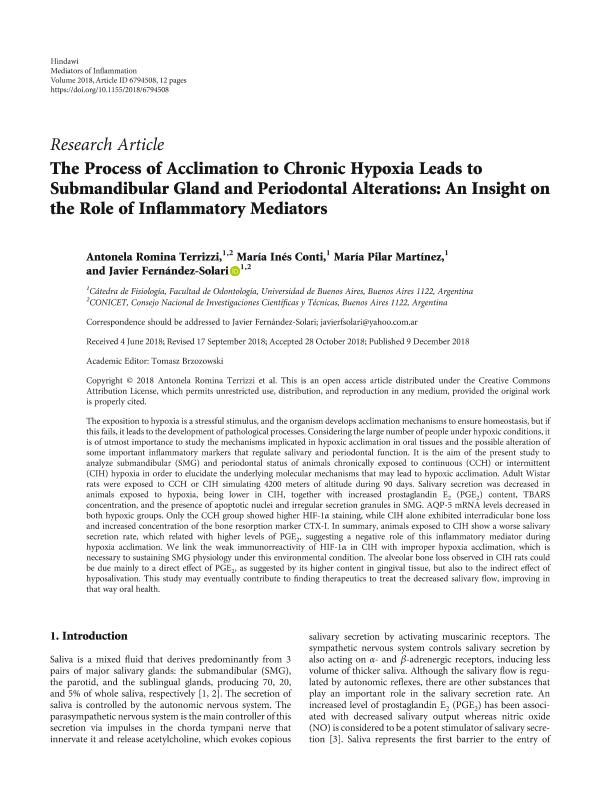Mostrar el registro sencillo del ítem
dc.contributor.author
Terrizzi, Antonela Romina

dc.contributor.author
Conti, Maria Ines

dc.contributor.author
Martinez, Maria del Pilar

dc.contributor.author
Fernández Solari, José Javier

dc.date.available
2020-03-12T19:25:32Z
dc.date.issued
2018-12
dc.identifier.citation
Terrizzi, Antonela Romina; Conti, Maria Ines; Martinez, Maria del Pilar; Fernández Solari, José Javier; The process of acclimation to chronic hypoxia leads to submandibular gland and periodontal alterations: An insight on the role of inflammatory mediators; Hindawi Publishing Corporation; Mediators of Inflammation; 2018; 12-2018; 1-12; 6794508
dc.identifier.issn
0962-9351
dc.identifier.uri
http://hdl.handle.net/11336/99324
dc.description.abstract
The exposition to hypoxia is a stressful stimulus, and the organism develops acclimation mechanisms to ensure homeostasis, but if this fails, it leads to the development of pathological processes. Considering the large number of people under hypoxic conditions, it is of utmost importance to study the mechanisms implicated in hypoxic acclimation in oral tissues and the possible alteration of some important inflammatory markers that regulate salivary and periodontal function. It is the aim of the present study to analyze submandibular (SMG) and periodontal status of animals chronically exposed to continuous (CCH) or intermittent (CIH) hypoxia in order to elucidate the underlying molecular mechanisms that may lead to hypoxic acclimation. Adult Wistar rats were exposed to CCH or CIH simulating 4200 meters of altitude during 90 days. Salivary secretion was decreased in animals exposed to hypoxia, being lower in CIH, together with increased prostaglandin E 2 (PGE 2 ) content, TBARS concentration, and the presence of apoptotic nuclei and irregular secretion granules in SMG. AQP-5 mRNA levels decreased in both hypoxic groups. Only the CCH group showed higher HIF-1α staining, while CIH alone exhibited interradicular bone loss and increased concentration of the bone resorption marker CTX-I. In summary, animals exposed to CIH show a worse salivary secretion rate, which related with higher levels of PGE 2 , suggesting a negative role of this inflammatory mediator during hypoxia acclimation. We link the weak immunorreactivity of HIF-1α in CIH with improper hypoxia acclimation, which is necessary to sustaining SMG physiology under this environmental condition. The alveolar bone loss observed in CIH rats could be due mainly to a direct effect of PGE 2 , as suggested by its higher content in gingival tissue, but also to the indirect effect of hyposalivation. This study may eventually contribute to finding therapeutics to treat the decreased salivary flow, improving in that way oral health.
dc.format
application/pdf
dc.language.iso
eng
dc.publisher
Hindawi Publishing Corporation

dc.rights
info:eu-repo/semantics/openAccess
dc.rights.uri
https://creativecommons.org/licenses/by-nc-sa/2.5/ar/
dc.subject
HYPOXIA
dc.subject
SALIVARY GLANDS
dc.subject
INFLAMATION
dc.subject.classification
Otras Ciencias de la Salud

dc.subject.classification
Ciencias de la Salud

dc.subject.classification
CIENCIAS MÉDICAS Y DE LA SALUD

dc.title
The process of acclimation to chronic hypoxia leads to submandibular gland and periodontal alterations: An insight on the role of inflammatory mediators
dc.type
info:eu-repo/semantics/article
dc.type
info:ar-repo/semantics/artículo
dc.type
info:eu-repo/semantics/publishedVersion
dc.date.updated
2020-03-10T12:24:15Z
dc.journal.volume
2018
dc.journal.pagination
1-12; 6794508
dc.journal.pais
Egipto

dc.journal.ciudad
El Cairo
dc.description.fil
Fil: Terrizzi, Antonela Romina. Universidad de Buenos Aires. Facultad de Odontología. Cátedra de Fisiología; Argentina. Consejo Nacional de Investigaciones Científicas y Técnicas; Argentina
dc.description.fil
Fil: Conti, Maria Ines. Universidad de Buenos Aires. Facultad de Odontología. Cátedra de Fisiología; Argentina. Consejo Nacional de Investigaciones Científicas y Técnicas; Argentina
dc.description.fil
Fil: Martinez, Maria del Pilar. Universidad de Buenos Aires. Facultad de Odontología. Cátedra de Fisiología; Argentina. Consejo Nacional de Investigaciones Científicas y Técnicas; Argentina
dc.description.fil
Fil: Fernández Solari, José Javier. Universidad de Buenos Aires. Facultad de Odontología. Cátedra de Fisiología; Argentina. Consejo Nacional de Investigaciones Científicas y Técnicas; Argentina
dc.journal.title
Mediators of Inflammation

dc.relation.alternativeid
info:eu-repo/semantics/altIdentifier/url/https://www.hindawi.com/journals/mi/2018/6794508/
dc.relation.alternativeid
info:eu-repo/semantics/altIdentifier/doi/https://doi.org/10.1155/2018/6794508
Archivos asociados
